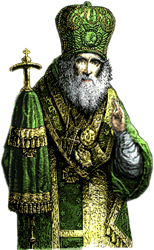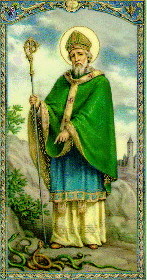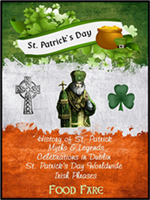|

Click here for Site Menu

The month of March
brings a much-needed break from winter weather. More important, it also brings
about March 17th, which is St. Patrick's Day.
St. Patrick's Day is
celebrated all over the world every year, by Irish and non-Irish alike. Who
hasn't heard of the great St. Patrick's Day parades in New York City and Boston?
Truth be told, there are more people of Irish descent living abroad than Celtic
souls occupying Ireland itself.
Descended from
Glendalough Irish on my father's side, I'm thrilled to be part of any Irish celebrations.
But where did it all
begin? And who was the real St. Patrick?
Lá Fhéile
Pádraig Sona Duit,

CONTENTS:
History of St. Patrick
Myths & Legends
Celebrations in Dublin
St. Patrick's Day Worldwide
St. Patrick's Blessing
Irish Phrases
Irish
Links
Terms of Use
Site Menu
HISTORY OF ST. PATRICK:
 Saint
Patrick (385-461 A.D.) is the patron saint of Ireland, and was chiefly
responsible for converting the Irish people to Christianity. Saint
Patrick (385-461 A.D.) is the patron saint of Ireland, and was chiefly
responsible for converting the Irish people to Christianity.
Saint Patrick was born
as Maewyn Succat in Bannavan Taburniae, near the Firth of Clyde in Britain. His
father was Calpurnius, a wealthy alderman. Calpurnius was also a deacon and the
son of Patitus, who was a priest.
When Patrick was
sixteen years old, he was abducted by pirates during a raid and sold into
slavery in Ireland. He became a shepherd to an Irish chief in Ulster. During his
captivity, Patrick devoted himself to religion. He escaped imprisonment after
six years of slavery, and managed to return to his home in Britain.
Patrick studied in the
monastery of Lerins, located on an island off the southeast coast of
France. He also studied religion under St. Germanus in Auxerre. Because
Patrick's education was minimal, his peers were reluctant to let him return to
Ireland as a missionary. However, Pope Celestine I finally sent Patrick to
Ireland in 431 A.D.
Patrick began his
work in northern and western Ireland, where Christianity had never been
preached. He gained the friendship and trust of many tribal chieftains, and soon
had many converts. It is said Patrick founded more than 300 churches and
baptized more than 125,000 people during his time. He also brought clergymen
from England and France to work in his churches.
As a
missionary in Ireland, Patrick also suffered hardship. He was imprisoned by the
Druids for a short time. In the twenty-eight years he spread the word of God, he
traveled far and wide, and not just in Ireland. There are countless places named
after him in Brittany, Cornwall, Wales, Scotland and Ireland.
Patrick preached
Christianity in Ireland for the remainder of his life. In his writings, a piece
called Confession was discovered, which was an account of his spiritual
development. In the writing, he expressed his humility and thankfulness to God
for calling on him to serve the Irish. He criticized a raid on Ireland led by
British chieftain Coroticus, during which many of Patrick's converts were
killed. The letter also makes obvious his resentment of the derisive
attitude of British clergymen and nobility toward the Irish.
One legend has it
that Saint Patrick died in A.D. 493, and was buried in the graves of St. Columba
and St. Bridget at Downpatrick, County Down, Ireland. His jawbone was preserved
in a silver shrine and was often requested in times of childbirth, epileptic
fits and as protection from the evil eye. Yet another legend claims Saint
Patrick died in Glastonbury and was buried there. The Chapel of St. Patrick
still exists as part of Glastonbury Abbey.
After his death, more
than four hundred Irish monasteries flourished as centers of learning. Patrick
also introduced the Roman alphabet and Latin literature into Ireland before his
death.
The Irish regard
Saint Patrick as their patron and guardian saint. Therefore, his feast day
(March 17th) is celebrated as a national holiday.
^ Back to top of page ^
ST. PATRICK MYTHS & LEGENDS:
 Two
of the most popular legends about St. Patrick - truth or fiction? You decide! Two
of the most popular legends about St. Patrick - truth or fiction? You decide!
THE SNAKES:
One of the most well-known legends
about St. Patrick is how he drove all the snakes from Ireland. In reality, there
are no snakes in Ireland to the present day.
Legend claims St. Patrick stood upon
a hill and used a wooden staff to drive all serpents into the sea, banishing
them forever from the shores of Ireland. However, one old serpent resisted the
saint's efforts. Patrick overcame him by sheer cunning, inviting the serpent
into a box. The snake thought the box too small, so an argument ensued between
Patrick and the reptile. At last, the serpent entered the box to prove he was
right, whereupon Patrick shut the lid to the box and cast it into the sea. There
have not been any snake sightings in Ireland since the island was separated from
the rest of the continent at the end of the ice age. Serpent symbols were common
in old pagan religions, and often worshipped. Driving the snakes from Ireland
was a symbol of ending pagan practices.
THE SHAMROCK & THE TRINITY:
Another legend has Saint Patrick
using the shamrock to demonstrate the idea of the Holy Trinity. In essence, the
Trinity is the Father, the Son, and the Holy Spirit. Many believe the shamrock
came to be the national symbol of Ireland as a result of the legend. Even though
Saint Patrick is celebrated each year on March 17th, it must be remembered that
Patrick spent his life sharing his belief in God and his message: the Father
(God); The Son and the Holy Spirit.
St. Patrick was never
officially canonized by a Pope. However, the Catholic Church has declared he is
"a saint in heaven."
^ Back to top of page ^
ST. PATRICK'S
DAY CELEBRATIONS IN DUBLIN:
As one can well imagine, celebrating St. Patrick in Ireland is a national event.
It is now a four-day festival, with Dublin hosting the biggest celebrations in
the country. It takes the city of Dublin five months to prepare for the events
each year. The St. Patrick's Festival was actually established by the Government
of Ireland in 1995. The main goal of the celebrations was to allow the Irish
people to celebrate their heritage, as well as express their own achievements
and talents.
The four-day calendar of celebrations includes some of the following:
Festival Parade
The St. Patrick's Day Parade takes place on March 17th, and normally starts at
noon. The progress winds its way through St. Patrick's Street, along Christchurch
Place, Dame Street, Westmoreland Street, O'Connell Street, and finishes on
Parnell Square West. There are marching bands and floats, as well as pre-parade
street entertainment. It is estimated that over a half-million people attend the
event, and millions others tune in via satellite television.
Skyfest
On March 16th, there is a fireworks display on the North and South Quays in
Dublin, from O'Connell Bridge to Cardiff Lane and Guild Street.
Opening Night
On March 16th, Dublin hosts opening night celebrations. Starting from the
River Liffey, thousands of performers walk through the streets, hopefully
gathering a crowd as they go.
Ceili Mor
This is a much-loved part of the St. Patrick's Festival and is typically held on
the evening of March 16th. The Ceili Mor celebrates Irish dance and traditional
Irish music.
Literary Treasure Hunt
On March 19th, the Literary Treasure Hunt takes place. The family event
highlights Dublin's literary landmarks and invites participants to discover and
solve the clues that lie within while finding out about many of Dublin's poets
and scribes.
Big Day Out
On March 16th, the heart of Dublin closes to street traffic, and a carnival
atmosphere seems to take hold of the people. There are displays of "street
theatre," music and mini-parades.
Bandfest
Late in the morning of March 16th, marching bands perform as a warm-up for the
parade, and people are allowed to have a sneak-peek.
Music Stage
In Dublin's Merrion Square, many musical groups perform from noon to six p.m. on
March 16th. The music ranges from traditional, to rock and roll, pop and
hip-hop.
^ Back to top of page ^
ST. PATRICK'S DAY
WORLDWIDE:
St. Patrick's Day is
celebrated all over the world, by almost every culture. The list below provides
a brief description of some of the worldwide events, and the cities and
countries who celebrate them:
Australia
Sydney hosts a
two-day St. Patrick's Festival in the "Rocks" area of the city, which includes
street markets, live music and an Irish film festival. Close to 150 floats
appear in the parade. Other major cities in Australia that put on big parades
are Melbourne, Brisbane, Adelaide and Fremantle.
Boston,
Massachusetts, USA
Boston is known as
the "Irish Capitol" of America (it is only five hours to Dublin by plane, after
all). The parade is large and highly attended. There are about forty Irish pubs
in Boston, which is also home to the "Famine Memorial."
Chicago, Illinois,
USA
The parade in Chicago
starts at Balbo and heads north to Columbus. Usually, the mayor walks in the
parade and there are over 100 floats.
Dubai, United Arab
Emirates
The Dubai Irish
Society hosts the annual St. Patrick's Day Ball. Festivities are also held at
Irish Village in Dubai, with music, dance shows and activities for the children.
Montreal, Canada
Public parade and
tributes to Irish films. The St. Patrick's Society hosts an annual lunch. The
parade normally follows St. Catherine's Street, and ends up at Place des Arts.
New York City, New
York, USA
In 2014, New York
City will host its 253rd annual St. Patrick's Day Parade, which usually takes
place in Manhattan.
New Zealand
The greater Auckland
community presents a festival that highlights Irish culture and traditions. The
19th Annual St. Patrick's Day Parade will take place in 2014.
Portland, Maine,
USA
The Irish American
Club sponsors the St. Patrick's Parade, where participants assemble at Fish Pier
on Commercial Street. The parade concludes at Maine State Pier with a Closing
Ceremony featuring music and dance.
St. Patrick,
Missouri, USA
Since 1936, this
community has held a St. Patrick's Day Parade through the town named after the
Irish saint.
San Francisco,
California, USA
A special mass is
held prior to the parade at St. Patrick's Church on Mission Street in San
Francisco. The year 2014 will mark the 162nd annual St. Patrick's Day Parade.
Savannah, Georgia,
USA
Over 500,000 visitors
pass through Savannah for the St. Patrick's Day Parade and other related events.
The "festival zone" is on River Street from MLK Boulevard, to Savannah Electric.
Tokyo, Japan
The St. Patrick's Day
Parade in Tokyo (Harajuku) is the biggest Irish event in Japan. It began in 1992
to introduce Irish culture to the Japanese people.
PLEASE NOTE: Because
of the ongoing COVID-19 pandemic, many cultural events celebrating St. Patrick's
Day have gone virtual. The Irish government announced in 2021 that a "virtual St
Patrick's Day initiative will be celebrated across the world in a series of
online events hosted by Ireland's embassies and consulates." In addition, the Irish Consulate
in New York City tweeted the following on March 9, 2021: "Delighted to announce
SHADES OF GREEN: CELEBRATING IRISH-AMERICA, a special virtual event this #StPatricksDay
at 7:30pm ET. Alongside outstanding music, dance & poetry, we'll hear remarkable
stories of Irish-America & the ties that bind our nations."
For more about St. Patrick's Day around the world,
visit the website St. Patrick's Day Events.
DID YOU KNOW?
Corned beef and cabbage is not a typical meal in an
Irish household. The dish is more of an "Americanism" for the occasion of St.
Patrick's Day. In Ireland, St. Patrick's Day dinner usually includes boiled
bacon or ham served with cabbage and jacket potatoes. Warm soda bread is often
served on the side.
^ Back to top of page ^
ST. PATRICK'S
BLESSING:
As he brought new
faith to Ireland
So may he bring out
in you
A touch of Irish
kindness
in everything you
do.
And through the
good St. Patrick
May your home and
life be blessed
with all the
special favors
That make you
happiest.

Lá Fhéile Pádraig
Sona Duit!
(Happy St.
Patrick's Day!)
^ Back to top of page ^
IRISH PHRASES:
The Irish have always been very
eloquent with words, thus the term "Gift of the Gab." What other country in the
world so reveres their writers as Ireland? There have been
many poems and literary masterpieces written by the Irish, but none so charming
and amusing as their blessings and phrases.
-
May you be in heaven a
half-hour before the devil knows your dead.
-
May the grass grow
long on the road to hell for want of use.
-
May you live to be a
hundred years, with one extra year to repent.
-
May the wind at your
back always be your own.
-
May the dust of your
carriage blind the eyes of your foe!
-
An Irishman is never
drunk as long as he can hold on to one blade of grass, and not fall off the
face of the earth.
-
May you never forget
what is worth remembering, or remember what is best forgotten.
-
May your blessings
outnumber the shamrocks that grow, and may trouble avoid you wherever you go.
-
Never reach out your
hand further than you can withdraw it.
-
I drink to your health
when I'm with you, I drink to your health when I'm alone, I drink to your
health so often, I'm starting to worry about my own.
-
May the good Saint
Patrick protect ye, and the Devil neglect ye!
-
May the enemies of
Ireland never eat bread nor drink whiskey, but be afflicted with itching
without the benefit of scratching.
-
May the horns of your
cattle always touch heather.
-
I have known many;
liked not a few; loved only one; so this toast's for you.
-
Here's to fire: Not
the fast and furious kind that burns down shacks and shanties. But the slow,
seductive kind that takes down pants and panties.
-
For the great Gaels of
Ireland; are the men that made God mad. For all their wars are merry; and all
their songs sad.
-
Here's to Eve, the
mother of us all; and here's to Adam, who was "Johnny on the Spot" when the
leaf began to fall.
-
Here's to your coffin:
May it be built of 100 year-old oaks, which I will plant tomorrow.
-
May God bring good
health to your enemy's enemies.
-
May the best day of
your past be the worst day of your future.
-
Death leaves a heartache no one can heal; Love leaves a memory no one
can steal.
^ Back to top of page ^
IRISH LINKS:
Off-site links open in a
new window.
Blarney Village
Field Guide to Irish Fairies
Food Fare: The Emerald Isle
Irish
Culture & Customs

Mythical Ireland
RTÉ
(Radio Telefís Éireann)
St. Patrick
Centre
St. Patrick's
Festival
Smaointe
(Irish greeting cards)
^ Back to top of page ^
TERMS OF USE:

(C)
Shenanchie
Reprinted exclusively for Food Fare
"St. Patrick's Day" was written for entertainment purposes only and expresses the sole
opinions of the author. This article is not meant to be a professional
essay about St. Patrick's Day, but rather an observation about the generalities of
the global Irish holiday.
You are free to use the material in this article as reference, but if you
happen to use direct wording from this piece, we would appreciate the credit.
Thank you.
To send Shenanchie a comment about this article, click
here.
FREE DOWNLOAD:
To download a free copy of "St. Patrick's Day" in Adobe Acrobat (PDF)
format, click here.

Click on book cover to view larger size in a new window.
RELATED LINK:
The Emerald Isle is part of Food Fare's
exclusive Culinary Collection, which contains a
selection of their food articles in e-book format, including Kindle, Kobo
and Nook.

FOOD FARE SITE MENU:

^ Back to top of page ^
|